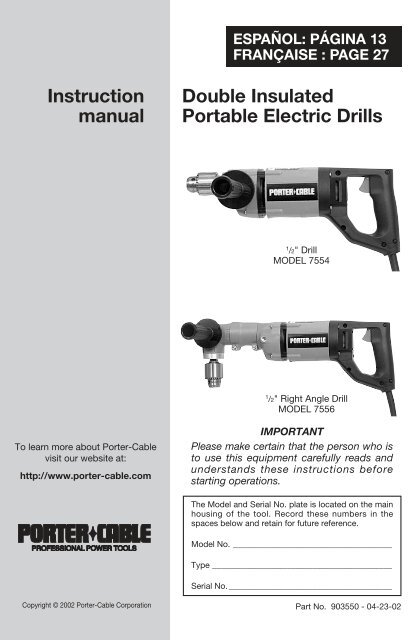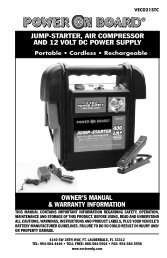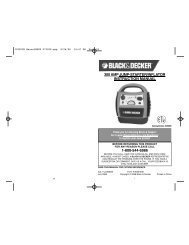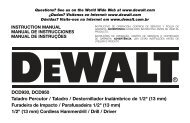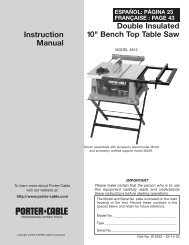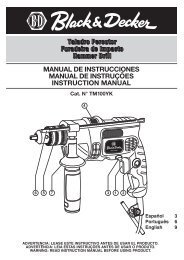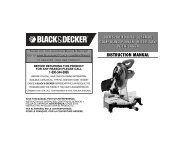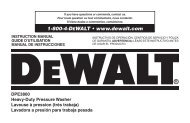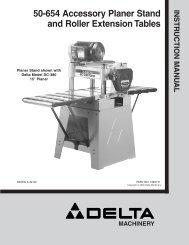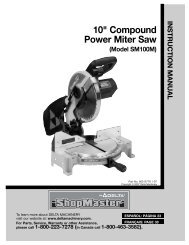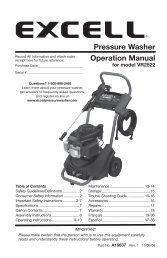Double Insulated Portable Electric Drills Instruction manual
Double Insulated Portable Electric Drills Instruction manual
Double Insulated Portable Electric Drills Instruction manual
You also want an ePaper? Increase the reach of your titles
YUMPU automatically turns print PDFs into web optimized ePapers that Google loves.
ESPAÑOL: PÁGINA 13<br />
FRANÇAISE : PAGE 27<br />
<strong>Instruction</strong><br />
<strong>manual</strong><br />
<strong>Double</strong> <strong>Insulated</strong><br />
<strong>Portable</strong> <strong>Electric</strong> <strong>Drills</strong><br />
1 /2" Drill<br />
MODEL 7554<br />
1 /2" Right Angle Drill<br />
MODEL 7556<br />
To learn more about Porter-Cable<br />
visit our website at:<br />
http://www.porter-cable.com<br />
IMPORTANT<br />
Please make certain that the person who is<br />
to use this equipment carefully reads and<br />
understands these instructions before<br />
starting operations.<br />
The Model and Serial No. plate is located on the main<br />
housing of the tool. Record these numbers in the<br />
spaces below and retain for future reference.<br />
Model No. ______________________________________<br />
Type ___________________________________________<br />
Serial No. _______________________________________<br />
Copyright © 2002 Porter-Cable Corporation<br />
Part No. 903550 - 04-23-02
WARNING: SOME DUST CREATED BY POWER SANDING, SAWING,<br />
GRINDING, DRILLING, AND OTHER CONSTRUCTION ACTIVITIES<br />
contains chemicals known to cause cancer, birth defects or other<br />
reproductive harm. Some examples of these chemicals are:<br />
· lead from lead-based paints,<br />
· crystalline silica from bricks and cement and other masonry products, and<br />
· arsenic and chromium from chemically-treated lumber.<br />
Your risk from these exposures varies, depending on how often you do this<br />
type of work. To reduce your exposure to these chemicals: work in a well<br />
ventilated area, and work with approved safety equipment, such as those<br />
dust masks that are specially designed to filter out microscopic particles.<br />
GENERAL SAFETY RULES<br />
WARNING: READ AND UNDERSTAND ALL INSTRUCTIONS. Failure<br />
to follow all instructions listed below, may result in electric shock, fire and/or<br />
serious personal injury.<br />
SAVE THESE INSTRUCTIONS.<br />
WORK AREA<br />
1. Keep your work area clean and well lit. Cluttered benches and dark<br />
areas invite accidents.<br />
2. Do not operate power tools in explosive atmospheres, such as in<br />
the presence of flammable liquids, gases, or dust. Power tools create<br />
sparks which may ignite the dust or fumes.<br />
3. Keep bystanders, children, and visitors away while operating a<br />
power tool. Distractions can cause you to lose control.<br />
ELECTRICAL SAFETY<br />
1. <strong>Double</strong> insulated tools are equipped with a polarized plug (one<br />
blade is wider than the other). This plug will fit in a polarized outlet only<br />
one way. If the plug does not fit fully in the outlet, reverse the plug. If it<br />
still does not fit, contact a qualified electrician to install a polarized<br />
outlet. Do not change the plug in any way. <strong>Double</strong> Insulation<br />
eliminates the need for the three wire grounded power cord and<br />
grounded power supply system.<br />
2. Avoid body contact with grounded surfaces such as pipes,<br />
radiators, ranges and refrigerators. There is an increased risk of electric<br />
shock if your body is grounded.<br />
3. Don’t expose power tools to rain or wet conditions. Water entering a<br />
power tool will increase the risk of electric shock.<br />
4. Do not abuse the cord. Never use the cord to carry the tools or pull<br />
the plug from an outlet. Keep cord away from heat, oil, sharp edges or<br />
moving parts. Replace damaged cords immediately. Damaged cords<br />
increase the risk of electric shock.<br />
5. When operating a power tool outside, use an outdoor extension<br />
cord marked “W-A” or “W”. These cords are rated for outdoor use and<br />
reduce the risk of electric shock.<br />
PERSONAL SAFETY<br />
1. Stay alert, watch what you are doing, and use common sense when<br />
operating a power tool. Do not use tool while tired or under the<br />
2
influence of drugs, alcohol, or medication. A moment of inattention while<br />
operating power tools may result in serious personal injury.<br />
2. Dress properly. Do not wear loose clothing or jewelry. Contain long<br />
hair. Keep your hair, clothing, and gloves away from moving parts.<br />
Loose clothes, jewelry, or long hair can be caught in moving parts.<br />
3. Avoid accidental starting. Be sure switch is OFF before plugging in.<br />
Carrying tools with your finger on the switch or plugging in tools that have<br />
the switch ON invites accidents.<br />
4. Remove adjusting keys or wrenches before turning the tool ON. A<br />
wrench or a key that is left attached to a rotating part of the tool may result in<br />
personal injury.<br />
5. Do not overreach. Keep proper footing and balance at all times.<br />
Proper footing and balance enables better control of the tool in unexpected<br />
situations.<br />
6. Use safety equipment. Always wear eye protection. Dust mask, nonskid<br />
safety shoes, hard hat, or hearing protection must be used for<br />
appropriate conditions.<br />
TOOLS USE AND CARE<br />
1. Use clamps or other practical way to secure and support the<br />
workpiece to a stable platform. Holding the work by hand or against your<br />
body is unstable and may lead to loss of control.<br />
2. Do not force tool. Use the correct tool for your application. The<br />
correct tool will do the job better and safer at the rate for which it is<br />
designed.<br />
3. Do not use tool if switch does not turn it ON or OFF. Any tool that<br />
cannot be controlled with the switch is dangerous and must be repaired.<br />
4. Disconnect the plug from the power source before making any<br />
adjustments, changing accessories, or storing the tool. Such preventive<br />
safety measures reduce the risk of starting the tool accidentally.<br />
5. Store idle tools out of reach of children and other untrained<br />
persons. Tools are dangerous in the hands of untrained users.<br />
6. Maintain tools with care. Keep cutting tools sharp and clean.<br />
Properly maintained tools, with sharp cutting edges are less likely to bind<br />
and are easier to control.<br />
7. Check for misalignment or binding of moving parts, breakage of<br />
parts, and any other condition that may affect the tool’s operation. If<br />
damaged, have the tool serviced before using. Many accidents are<br />
caused by poorly maintained tools.<br />
8. Use only accessories that are recommended by the manufacturer<br />
for your model. Accessories that may be suitable for one tool may become<br />
hazardous when used on another tool.<br />
SERVICE<br />
1. Tool service must be performed only by qualified repair personnel.<br />
Service or maintenance performed by unqualified personnel could result in a<br />
risk of injury.<br />
2. When servicing a tool, use only identical replacement parts. Follow<br />
instructions in the Maintenance Section of this <strong>manual</strong>. Use of<br />
unauthorized parts or failure to follow Maintenance <strong>Instruction</strong>s may create a<br />
risk of electric shock or injury.<br />
3
SPECIFIC SAFETY RULES AND SYMBOLS FOR PORTABLE<br />
DRILLS<br />
1. HOLD TOOL BY INSULATED GRIPPING SURFACES WHEN<br />
PERFORMING AN OPERATION WHERE THE CUTTING TOOLS MAY<br />
CONTACT HIDDEN WIRING OR ITS OWN CORD. Contact with a “live”<br />
wire will make exposed metal parts of the tool “live” and shock the operator.<br />
2. ALWAYS hold drill by the handle(s) ONLY to prevent accidental electrical<br />
shock resulting from cutting a live wire when drilling into a wall or other blind<br />
areas.<br />
3. DO NOT use bits larger than those recommended in Fig. A. They<br />
increase the chance of jamming. Large bits may also overload the drill and<br />
damage the motor and gears.<br />
4. USE ONLY the proper chuck key to tighten or loosen the chuck. Do not<br />
use chuck if jaws or other parts are cracked or worn.<br />
5. VERIFY the drill’s rotation before starting the drill so it is correct for the<br />
operation being performed.<br />
6. NEVER change direction of rotation of reversing model until motor has<br />
completely stopped.<br />
7. NEVER hold work in your hand, lap, or against other parts of your body<br />
when drilling.<br />
8. DO NOT use drill as a router or try to elongate or enlarge holes by<br />
twisting the drill. Drill bits may break and cause injury.<br />
9. SOME WOOD CONTAINS PRESERVATIVES WHICH CAN BE TOXIC.<br />
Take extra care to prevent inhalation and skin contact when working with<br />
these materials. Request, and follow, any safety information available from<br />
your material supplier.<br />
10. WARNING: There are certain applications for which this tool was<br />
designed. Porter-Cable strongly recommends that this tool NOT be modified<br />
and/or used for any application other than for which it was designed. If you<br />
have any questions relative to its application DO NOT use the tool until you<br />
have written Porter-Cable and we have advised you.<br />
Technical Service Manager<br />
Porter-Cable Corporation<br />
4825 Highway 45 North<br />
Jackson, TN 38305<br />
SYMBOL<br />
DEFINITION<br />
V ........................ volts<br />
A ........................ amperes<br />
Hz ........................ hertz<br />
W ........................ watts<br />
kW ........................ kilowatts<br />
µF ........................ microfarads<br />
l ........................ liters<br />
kg ........................ kilograms<br />
N/cm 2 ........................ newtons per square centimeter<br />
Pa ........................ pascals<br />
h ........................ hours<br />
min ........................ minutes<br />
s ........................ seconds<br />
........................ alternating current<br />
3 ........................ three-phase alternating current<br />
3N ........................ three-phase alternating current with neutral<br />
4
........................ direct current<br />
n 0 ........................ no load<br />
........................ alternating or direct current<br />
........................ Class II Construction<br />
........................ splash-proof construction<br />
........................ watertight construction<br />
…/min ........................ revolutions or reciprocation per minute<br />
REPLACEMENT PARTS<br />
When servicing use only identical replacement parts.<br />
MOTOR<br />
Many Porter-Cable tools will operate on either D.C., or single phase 25 to 60<br />
cycle A.C. current and voltage within plus or minus 5 percent of that shown<br />
on the specification plate on the tool. Several models, however, are designed<br />
for A.C. current only. Refer to the specification plate on your tool for proper<br />
voltage and current rating.<br />
CAUTION: Do not operate your tool on a current on which the<br />
voltage is not within correct limits. Do not operate tools rated A.C.<br />
only on D.C. current. To do so may seriously damage the tool.<br />
EXTENSION CORD SELECTION<br />
If an extension cord is used, make sure the conductor size is large enough to<br />
prevent excessive voltage drop which will cause loss of power and possible<br />
motor damage. A table of recommended extension cord sizes will be found<br />
in this section. This table is based on limiting line voltage drop to 5 volts (10<br />
volts for 230 volts) at 150% of rated amperes.<br />
If an extension cord is to be used outdoors it must be marked with the suffix<br />
W-A or W following the cord type designation. For example – SJTW-A to<br />
indicate it is acceptable for outdoor use.<br />
RECOMMENDED EXTENSION CORD SIZES FOR USE WITH PORTABLE ELECTRIC TOOLS<br />
Nameplate Ampere Rating<br />
Length of Cord in Feet<br />
115V 25 Ft. 50 Ft. 100 Ft. 150 Ft. 200 Ft. 250 Ft. 300 Ft. 400 Ft. 500 Ft.<br />
230V 50 Ft. 100 Ft. 200 Ft. 300 Ft. 400 Ft. 500 Ft. 600 Ft. 800 Ft. 1000 Ft.<br />
0-2 18 18 18 16 16 14 14 12 12<br />
2-3 18 18 16 14 14 12 12 10 10<br />
3-4 18 18 16 14 12 12 10 10 8<br />
4-5 18 18 14 12 12 10 10 8 8<br />
5-6 18 16 14 12 10 10 8 8 6<br />
6-8 18 16 12 10 10 8 6 6 6<br />
8-10 18 14 12 10 8 8 6 6 4<br />
10-12 16 14 10 8 8 6 6 4 4<br />
12-14 16 12 10 8 6 6 6 4 2<br />
14-16 16 12 10 8 6 6 4 4 2<br />
16-18 14 12 8 8 6 4 4 2 2<br />
18-20 14 12 8 6 6 4 4 2 2<br />
5
FUNCTIONAL DESCRIPTION<br />
FOREWORD<br />
Porter-Cable drills are designed to drill holes of various sizes in wood and<br />
metal as indicated in the following chart:<br />
Model No. of Drill Type of Bit Max. Dia. Hole Material<br />
7554<br />
Twist Drill 1 /2" Steel<br />
Auger Bit 1 3 /4" Wood<br />
Low Twist Drill 1 /2" Steel<br />
Speed Auger Bit 1 3 /4" Wood<br />
7556 Self Feed Bit 4 5 /8" Wood<br />
High Twist Drill 1 /2" Steel<br />
Speed Auger Bit 1 1 /2" Wood<br />
Self Feed Bit 2 9 /16" Wood<br />
Fig. A<br />
INSTALLING AND REMOVING DRILL BIT<br />
1. CAUTION: DISCONNECT TOOL FROM POWER SOURCE.<br />
2. The three-jaw chuck is designed for self-centering of the drill bit. Open<br />
chuck jaws by turning outer sleeve counterclockwise, when viewing the<br />
chuck from the bit end. Open large enough so that bit shank can be inserted.<br />
3. Clean and insert smooth end of drill bit as far as it will go into the chuck,<br />
then withdraw bit approximately 1 /16", or up to the flutes for small bits.<br />
4. While holding the bit with one hand, turn outer sleeve clockwise until bit<br />
is gripped in the chuck.<br />
5. Tighten chuck – insert chuck key into each of 3 keyholes in chuck body<br />
(Fig. 1) in succession and tighten securely by turning key clockwise.<br />
CAUTION: Be sure chuck key is removed before starting tool.<br />
6. To remove bit, reverse this procedure.<br />
LOOSEN<br />
TIGHTEN<br />
Fig. 1<br />
6
ASSEMBLY<br />
TO INSTALL AUXILIARY HANDLE<br />
An auxiliary handle (C) Fig. 2, is supplied and can be installed on either side<br />
of the tool. This handle screws directly into the drill housing providing<br />
complete control of the drill.<br />
It is strongly recommended that the auxiliary handle be used and tool held as<br />
illustrated in Fig. 3A during all drilling operations.<br />
Model 7554<br />
A<br />
E G A<br />
C<br />
B<br />
C<br />
F<br />
Model 7556<br />
B<br />
Fig. 2<br />
OPERATION<br />
TO START AND STOP DRILL<br />
1. Make sure drill switch is “OFF”. Make sure power circuit voltage is the<br />
same as that shown on the specification plate of the drill. Connect drill to<br />
power circuit.<br />
2. Squeeze TRIGGER SWITCH (A) Fig. 2, to start motor. Release trigger to<br />
stop motor.<br />
3. A REVERSING SWITCH (B) Fig. 2 – is provided with either model. These<br />
models will operate in either the forward direction (clockwise rotation) for<br />
drilling holes, or the reverse direction (counterclock-wise rotation) for<br />
releasing jammed drill bits. For counterclockwise rotation, stop the motor by<br />
releasing the trigger switch and move the reversing switch to the position<br />
labeled “R”, or in the opposite direction for clockwise rotation.<br />
NOTE: Never attempt to change direction of rotation while switch is<br />
“ON”. To do so, may damage the drill. Be sure switch is “OFF” and<br />
motor has completely stopped before changing direction of rotation.<br />
4. In VARIABLE SPEED mode, as the trigger switch is squeezed, the drill<br />
speed increases.<br />
RIGHT ANGLE DRILL<br />
The Right Angle <strong>Drills</strong> are operated in the same manner as the conventional<br />
straight drive drills. All right angle drills are factory assembled with the chuck<br />
on drive end marked “LOW” and will run at the lower RPM shown on the<br />
specification plate.<br />
To change to the higher RPM marked on the nameplate proceed as follows:<br />
1. CAUTION: DISCONNECT TOOL FROM POWER SOURCE.<br />
2. Loosen the outer sleeve screw (F) Fig. 2, and slide the right angle drive<br />
(E) Fig. 2, from the sleeve (G) Fig. 2 just far enough to disengage drive shaft<br />
from coupling.<br />
3. Open chuck jaws as wide as possib1e to gain access to chuck retaining<br />
screw.<br />
7
REMOVE CHUCK<br />
INSTALL CHUCK<br />
Fig. 3<br />
4. Place spindle wrench (furnished with drill) on flats of spindle shaft and<br />
hold. With a 3 /16" hex wrench, turn the retaining screw clockwise (left hand<br />
threads) and remove from chuck.<br />
5. While supporting chuck on a solid surface, place wrench on flats of<br />
spindle and allow the opposite end of wrench to rest on the workbench to<br />
your left as shown in Fig. 3. Place chuck pin wrench into chuck key hole so<br />
that pin wrench extends to your left as shown in Fig. 3. Strike the pin wrench<br />
a sharp blow with a hammer to loosen chuck.<br />
6. Turn chuck counterclockwise to unscrew. Remove chuck and two<br />
washers from spindle.<br />
7. Place steel washer and then brass washer (washers removed in Step 6)<br />
onto spindle at end of right angle drive marked “high”.<br />
NOTE: Failure to use these washers may cause chuck to seize on<br />
spindle.<br />
8. Thread chuck onto spindle (“HIGH” end of drive) and seat firmly by<br />
reversing procedure in Step 5.<br />
9. Tighten chuck retaining screw securely.<br />
10. Replace right angle drive to sleeve, making sure the flats on the<br />
driveshaft engage slot in coupling.<br />
11. Tighten sleeve screws securely.<br />
Right Angle <strong>Drills</strong> may be converted to a conventional straight drive drill by<br />
loosening the back sleeve screw and removing the sleeve and right angle<br />
drive from the drill. Remove the coupling retaining screw (hold spindle with<br />
spindle wrench, turn screw clockwise with a 5 /32" hex wrench) and coupling.<br />
Remove the chuck and washers from the right angle drive and assemble to<br />
drill spindle.<br />
NOTE: Chuck must be firmly seated on spindle before installing<br />
chuck retaining screw.<br />
HOW TO HOLD THE DRILL<br />
WARNING: The front end of drill may be made live if the tool drills<br />
into live wiring in a wall. TO PREVENT ACCIDENTAL ELECTRICAL<br />
SHOCK, DRILL MUST BE HELD AS SHOWN IN FIG. 3A.<br />
An auxiliary handle (C) Fig. 2, is supplied with each drill.<br />
8
D-HANDLE DRILL Model 7554<br />
RIGHT ANGLE DRILL Model 7556<br />
Fig. 3A<br />
HOW TO USE THE DRILL<br />
GENERAL DRILLING<br />
1. Be sure drill bit is securely gripped in chuck. (See INSTALLING AND<br />
REMOVING DRILL BIT).<br />
2. Set REVERSING SWITCH for clockwise rotation.<br />
3. Make sure work is held securely in vise or clamped in place prior to<br />
starting drilling operation.<br />
CAUTION: Loose work may spin and cause bodily injury.<br />
4. Locate exact center for hole to be drilled and using a center punch,<br />
make a small dent in work.<br />
5. Place tip of drill bit in dent made by center punch, hold drill square with<br />
work, and start the motor.<br />
6. Apply steady, even pressure to keep drill bit cutting. Too little pressure<br />
will keep the bit from cutting and dull the edges due to excessive friction<br />
created by sliding over the surface.<br />
CAUTlON: Too much pressure may cause the bit to break or<br />
overheat resulting in bodily injury or damaged drill bits.<br />
CAUTION: BE ALERT and brace yourself against the twisting action<br />
of the drill, should bit jam in the work.<br />
7. If drill stalls or becomes jammed in the hole, release trigger immediately,<br />
remove drill bit from work and determine cause of stalling or jamming. DO<br />
NOT SQUEEZE TRIGGER ON AND OFF IN AN ATTEMPT TO FREE A<br />
STALLED OR JAMMED DRILL – THIS WILL DAMAGE THE MOTOR. The<br />
direction of rotation may be reversed to help free a jammed bit. Be sure<br />
direction of rotation is RESET before attempting to continue drilling.<br />
9
8. Reduce the pressure on the drill just before the bit cuts through the work<br />
to avoid splintering wood or stalling in metal.<br />
9. When bit has completely penetrated work and is spinning freely,<br />
withdraw it from the work while the motor is still running, then turn off drill.<br />
DRILLING WOOD<br />
WARNING: SOME WOOD CONTAINS PRESERVATIVES WHICH<br />
CAN BE TOXIC. Take extra care to prevent inhalation and skin<br />
contact when working with these materials. Request, and follow, any<br />
safety information available from your material supplier.<br />
In addition to the instructions listed under GENERAL DRlLLlNG, the following<br />
also apply:<br />
1. When using twist drills in wood, they should be withdrawn from the hole<br />
frequently to clear chips built up in flutes to avoid overheating and burning<br />
work.<br />
2. If a backing block is used to keep back of work from splintering, it<br />
should be clamped securely in place. If a backing block is not used with<br />
spade bits or auger bits, ease up pressure as soon as bit point breaks<br />
through work, and complete the hole from the opposite side.<br />
DRILLING METAL<br />
In addition to the instructions listed under GENERAL DRlLLlNG, the following<br />
also apply:<br />
CAUTlON: When drilling metal, jamming of bit is more likely than<br />
when drilling other materials.<br />
1. Use only good quality sharp high speed steel twist bits when drilling<br />
metal.<br />
2. Start drilling with slow speed and gradually increase speed as drill cuts.<br />
The harder the material, the slower the speed required. The softer the<br />
material, the faster the speed.<br />
3. When drilling a large hole, it is easier to first drill a smaller hole and then<br />
enlarge it to the required size.<br />
4. The use of a lubricant, such as oil, on the drill point helps keep the bit<br />
cool, increases drilling action and prolongs drill bit life.<br />
MAINTENANCE<br />
KEEP TOOL CLEAN<br />
Periodically blow out all air passages with dry compressed air. All plastic<br />
parts should be cleaned with a soft damp cloth. NEVER use solvents to clean<br />
plastic parts. They could possibly dissolve or otherwise damage the material.<br />
CAUTION: Wear safety glasses while using compressed air.<br />
FAILURE TO START<br />
Should your tool fail to start, check to make sure the prongs on the cord plug<br />
are making good contact in the outlet. Also, check for blown fuses or open<br />
circuit breakers in the line.<br />
10
CHUCK REPLACEMENT<br />
MODEL 7556 RIGHT ANGLE DRILL – see steps 5 through 11 and Fig. 3 in<br />
(RIGHT ANGLE DRILL) section of this <strong>manual</strong>.<br />
MODEL 7554 – PROCEED AS FOLLOWS:<br />
1. CAUTION: DISCONNECT TOOL FROM POWER SOURCE.<br />
2. Open chuck jaws as wide as possible to gain access to the chuck<br />
retaining screw.<br />
3. Remove chuck retaining screw using 3 /16" hex wrench. Turn screw<br />
clockwise to remove.<br />
4. Remove chuck: place the short end of a large hex wrench ( 1 /4" or larger)<br />
into the chuck. Align wrench flats with chuck jaws and tighten chuck securely<br />
using chuck key. While supporting chuck on a solid surface, position hex<br />
wrench to left (see Fig. 4) and strike wrench a sharp blow with a hammer to<br />
loosen chuck. Turn chuck counterclockwise to remove.<br />
NOTE: The washer(s) should remain on the spindle for use with the<br />
replacement chuck.<br />
5. INSTALL CHUCK: Open jaws of replacement chuck as wide as possible.<br />
Thread chuck by turning chuck clock-wise. Hand tighten. Install hex wrench<br />
in chuck (see Step 5). While supporting chuck on a solid surface, position<br />
hex wrench to the right (see Fig. 5) and strike a sharp blow with a hammer to<br />
seat chuck onto spindle.<br />
6. Remove hex wrench from chuck.<br />
7. INSTALL CHUCK RETAINING SCREW: Turn screw counterclockwise<br />
with a 3 /16" hex wrench. Tighten securely.<br />
REMOVE<br />
CHUCK<br />
INSTALL<br />
CHUCK<br />
Fig. 4 Fig. 5<br />
LUBRICATION<br />
This tool has been lubricated with a sufficient amount of high grade lubricant<br />
for the life of the unit under normal operating conditions. No further<br />
lubrication is necessary.<br />
BRUSH INSPECTION AND LUBRICATION<br />
For your continued safety and electrical protection, brush inspection and<br />
replacement on this tool should ONLY be performed by an AUTHORIZED<br />
PORTER-CABLE SERVICE STATION or a PORTER-CABLE/DELTA<br />
FACTORY SERVICE CENTER.<br />
11
At approximately 100 hours of use, take or send your tool to your nearest<br />
authorized Porter-Cable Service Station to be thoroughly cleaned and<br />
inspected. Have worn parts replaced and lubricate with fresh lubricant. Have<br />
new brushes installed, and test the tool for performance.<br />
Any loss of power before the above maintenance check may indicate the<br />
need for immediate servicing of your tool. DO NOT CONTINUE TO<br />
OPERATE TOOL UNDER THIS CONDITION. If proper operating voltage is<br />
present, return your tool to the service station for immediate service.<br />
SERVICE AND REPAIRS<br />
All quality tools will eventually require servicing or replacement of parts due<br />
to wear from normal use. These operations, including brush inspection and<br />
replacement, should ONLY be performed by either an AUTHORIZED<br />
PORTER-CABLE SERVICE STATION or a PORTER-CABLE/DELTA<br />
FACTORY SERVICE CENTER. All repairs made by these agencies are fully<br />
guaranteed against defective material and workmanship. We cannot<br />
guarantee repairs made or attempted by anyone other than these agencies.<br />
Should you have any questions about your tool, feel free to write us at any<br />
time. In any communications, please give all information shown on the<br />
nameplate of your tool (model number, type, serial number, etc.).<br />
ACCESSORIES<br />
A complete line of accessories is available from your Porter-Cable •<br />
Delta Supplier, Porter-Cable • Delta Factory Service Centers, and<br />
Porter-Cable Authorized Service Stations. Please visit our Web Site<br />
www.porter-cable.com for a catalog or for the name of your nearest<br />
supplier.<br />
WARNING: Since accessories other than those offered by Porter-Cable<br />
• Delta have not been tested with this product, use of such accessories<br />
could be hazardous. For safest operation, only Porter-Cable • Delta<br />
recommended accessories should be used with this product.<br />
PORTER-CABLE LIMITED<br />
ONE YEAR WARRANTY<br />
Porter-Cable warrants its Professional Power Tools for a period of one year from the date of original<br />
purchase. We will repair or replace at our option, any part or parts of the product and accessories<br />
covered under this warranty which, after examination, proves to be defective in workmanship or<br />
material during the warranty period. For repair or replacement return the complete tool or accessory,<br />
transportation prepaid, to your nearest Porter-Cable Service Center or Authorized Service Station.<br />
Proof of purchase may be required. This warranty does not apply to repair or replacement required<br />
due to misuse, abuse, normal wear and tear or repairs attempted or made by other than our Service<br />
Centers or Authorized Service Stations.<br />
ANY IMPLIED WARRANTY, INCLUDING THE IMPLIED WARRANTIES OF MERCHANTABILITY AND<br />
FITNESS FOR A PARTICULAR PURPOSE, WILL LAST ONLY FOR ONE (1) YEAR FROM THE DATE<br />
OF PURCHASE.<br />
To obtain information on warranty performance please write to: PORTER-CABLE CORPORATION,<br />
4825 Highway 45 North, Jackson, Tennessee 38305; Attention: Product Service. THE FOREGOING<br />
OBLIGATION IS PORTER-CABLE’S SOLE LIABILITY UNDER THIS OR ANY IMPLIED WARRANTY<br />
AND UNDER NO CIRCUMSTANCES SHALL PORTER-CABLE BE LIABLE FOR ANY INCIDENTAL<br />
OR CONSEQUENTIAL DAMAGES. Some states do not allow limitations on how long an implied<br />
warranty lasts or the exclusion or limitation of incidental or consequential damages, so the above<br />
limitation or exclusion may not apply to you.<br />
This warranty gives you specific legal rights and you may also have other legal rights which vary<br />
from state to state.<br />
12
PORTER-CABLE • DELTA SERVICE CENTERS<br />
(CENTROS DE SERVICIO DE PORTER-CABLE • DELTA)<br />
(CENTRE DE SERVICE PORTER-CABLE • DELTA)<br />
Parts and Repair Service for Porter-Cable • Delta Power Tools are Available at These Locations<br />
(Obtenga Refaccion de Partes o Servicio para su Herramienta en los Siguientes Centros de Porter-Cable • Delta)<br />
(Locations où vous trouverez les pièces de rechange nécessaires ainsi qu’un service d’entretien)<br />
ARIZONA<br />
Tempe 85282 (Phoenix)<br />
2400 West Southern Avenue<br />
Suite 105<br />
Phone: (602) 437-1200<br />
Fax: (602) 437-2200<br />
CALIFORNIA<br />
Ontario 91761 (Los Angeles)<br />
3949A East Guasti Road<br />
Phone: (909) 390-5555<br />
Fax: (909) 390-5554<br />
San Leandro 94577 (Oakland)<br />
3039 Teagarden Street<br />
Phone: (510) 357-9762<br />
Fax: (510) 357-7939<br />
COLORADO<br />
Arvada 80003 (Denver)<br />
8175 Sheridan Boulevard, Unit S<br />
Phone: (303) 487-1809<br />
Fax: (303) 487-1868<br />
FLORIDA<br />
Davie 33314 (Miami)<br />
4343 South State Rd. 7 (441)<br />
Unit #107<br />
Phone: (954) 321-6635<br />
Fax: (954) 321-6638<br />
Tampa 33609<br />
4538 W. Kennedy Boulevard<br />
Phone: (813) 877-9585<br />
Fax: (813) 289-7948<br />
GEORGIA<br />
Forest Park 30297 (Atlanta)<br />
5442 Frontage Road, Suite 112<br />
Phone: (404) 608-0006<br />
Fax: (404) 608-1123<br />
ILLINOIS<br />
Addison 60101 (Chicago)<br />
400 South Rohlwing Road<br />
Phone: (630) 424-8805<br />
Fax: (630) 424-8895<br />
Woodridge 60517 (Chicago)<br />
2033 West 75th Street<br />
Phone: (630) 910-9200<br />
Fax: (630) 910-0360<br />
MARYLAND<br />
Elkridge 21075 (Baltimore)<br />
7397-102 Washington Blvd.<br />
Phone: (410) 799-9394<br />
Fax: (410) 799-9398<br />
MASSACHUSETTS<br />
Braintree 02185 (Boston)<br />
719 Granite Street<br />
Phone: (781) 848-9810<br />
Fax: (781) 848-6759<br />
Franklin 02038 (Boston)<br />
Franklin Industrial Park<br />
101E Constitution Blvd.<br />
Phone: (508) 520-8802<br />
Fax: (508) 528-8089<br />
MICHIGAN<br />
Madison Heights 48071 (Detroit)<br />
30475 Stephenson Highway<br />
Phone: (248) 597-5000<br />
Fax: (248) 597-5004<br />
MINNESOTA<br />
Minneapolis 55429<br />
5522 Lakeland Avenue North<br />
Phone: (763) 561-9080<br />
Fax: (763) 561-0653<br />
MISSOURI<br />
North Kansas City 64116<br />
1141 Swift Avenue<br />
P.O. Box 12393<br />
Phone: (816) 221-2070<br />
Fax: (816) 221-2897<br />
St. Louis 63119<br />
7574 Watson Road<br />
Phone: (314) 968-8950<br />
Fax: (314) 968-2790<br />
NEW YORK<br />
Flushing 11365-1595 (N.Y.C.)<br />
175-25 Horace Harding Expwy.<br />
Phone: (718) 225-2040<br />
Fax: (718) 423-9619<br />
NORTH CAROLINA<br />
Charlotte 28270<br />
9129 Monroe Road, Suite 115<br />
Phone: (704) 841-1176<br />
Fax: (704) 708-4625<br />
OHIO<br />
Columbus 43214<br />
4560 Indianola Avenue<br />
Phone: (614) 263-0929<br />
Fax: (614) 263-1238<br />
Cleveland 44125<br />
8001 Sweet Valley Drive Unit #19<br />
Phone: (216) 447-9030<br />
Fax: (216) 447-3097<br />
OREGON<br />
Portland 97230<br />
4916 NE 122 nd Ave.<br />
Phone: (503) 252-0107<br />
Fax: (503) 252-2123<br />
PENNSYLVANIA<br />
Willow Grove 19090<br />
520 North York Road<br />
Phone: (215) 658-1430<br />
Fax: (215) 658-1433<br />
TEXAS<br />
Carrollton 75006 (Dallas)<br />
1300 Interstate 35 N, Suite 112<br />
Phone: (972) 446-2996<br />
Fax: (972) 446-8157<br />
Houston 77055<br />
West 10 Business Center<br />
1008 Wirt Road, Suite 120<br />
Phone: (713) 682-0334<br />
Fax: (713) 682-4867<br />
WASHINGTON<br />
Auburn 98001 (Seattle)<br />
3320 West Valley HWY, North<br />
Building D, Suite 111<br />
Phone: (253) 333-8353<br />
Fax: (253) 333-9613<br />
Authorized Service Stations are located in many large cities. Telephone 800-487-8665 or 731-541-6042 for assistance locating one.<br />
Parts and accessories for Porter-Cable • Delta products should be obtained by contacting any Porter-Cable • Delta Distributor,<br />
Authorized Service Center, or Porter-Cable • Delta Factory Service Center. If you do not have access to any of these, call 888-848-5175<br />
and you will be directed to the nearest Porter-Cable • Delta Factory Service Center. Las Estaciones de Servicio Autorizadas están<br />
ubicadas en muchas grandes ciudades. Llame al 800-487-8665 ó al 731-541-6042 para obtener asistencia a fin de localizar una. Las<br />
piezas y los accesorios para los productos Porter-Cable • Delta deben obtenerse poniéndose en contacto con cualquier distribuidor<br />
Porter-Cable • Delta, Centro de Servicio Autorizado o Centro de Servicio de Fábrica Porter-Cable • Delta. Si no tiene acceso a ninguna<br />
de estas opciones, llame al 888-848-5175 y le dirigirán al Centro de Servicio de Fábrica Porter-Cable • Delta más cercano. Des centres<br />
de service agréés sont situés dans beaucoup de grandes villes. Appelez au 800-487-8665 ou au 731-541-6042 pour obtenir de l’aide<br />
pour en repérer un. Pour obtenir des pièces et accessoires pour les produits Porter-Cable • Delta, s’adresser à tout distributeur Porter-<br />
Cable • Delta, centre de service agréé ou centre de service d’usine Porter-Cable • Delta. Si vous n’avez accès à aucun de ces centres,<br />
appeler le 888-848-5175 et on vous dirigera vers le centre de service d’usine Porter-Cable • Delta le plus proche.<br />
CANADIAN PORTER-CABLE • DELTA SERVICE CENTERS<br />
ALBERTA<br />
Bay 6, 2520-23rd St. N.E.<br />
Calgary, Alberta<br />
T2E 8L2<br />
Phone: (403) 735-6166<br />
Fax: (403) 735-6144<br />
BRITISH COLUMBIA<br />
8520 Baxter Place<br />
Burnaby, B.C.<br />
V5A 4T8<br />
Phone: (604) 420-0102<br />
Fax: (604) 420-3522<br />
MANITOBA<br />
1699 Dublin Avenue<br />
Winnipeg, Manitoba<br />
R3H 0H2<br />
Phone: (204) 633-9259<br />
Fax: (204) 632-1976<br />
ONTARIO<br />
505 Southgate Drive<br />
Guelph, Ontario<br />
N1H 6M7<br />
Phone: (519) 836-2840<br />
Fax: (519) 767-4131<br />
QUÉBEC<br />
1515 Ave.<br />
St-Jean Baptiste,<br />
Québec, Québec<br />
G2E 5E2<br />
Phone: (418) 877-7112<br />
Fax: (418) 877-7123<br />
1447, Begin<br />
St-Laurent, (Montréal), Québec<br />
H4R 1V8<br />
Phone: (514) 336-8772<br />
Fax: (514) 336-3505<br />
The following are trademarks of PORTER-CABLE • DELTA (Las siguientes son marcas registradas de PORTER-CABLE • DELTA S.A.) (Les<br />
marques suivantes sont des marques de fabriquant de la PORTER-CABLE • DELTA): BAMMER ® , LASERLOC ® , OMNIJIG ® , POCKET CUTTER ® ,<br />
PORTA-BAND ® , PORTA-PLANE ® , PORTER-CABLE ® , QUICKSAND ® , SANDTRAP ® , SAW BOSS ® , SPEED-BLOC ® , SPEEDMATIC ® ,<br />
SPEEDTRONIC ® , STAIR-EASE ® , THE PROFESSIONAL EDGE ® , THE PROFESSIONAL SELECT ® , TIGER CUB ® , TIGER SAW ® , TORQ-BUSTER ® ,<br />
VERSA-PLANE ® , WHISPER SERIES ® , DURATRONIC, FRAME SAW, INNOVATION THAT WORKS, JETSTREAM, MICRO-SET,<br />
MORTEN, NETWORK, RIPTIDE, TRU-MATCH, WOODWORKER’S CHOICE, THE AMERICAN WOOD SHOP (design) , AUTO-<br />
SET, B.O.S.S., BUILDER’S SAW, CONTRACTOR’S SAW, DELTA, DELTACRAFT, HOMECRAFT, JET-LOCK, KICKSTAND,<br />
THE LUMBER COMPANY (design). MICRO-SET, Q3, QUICKSET II, QUICKSET PLUS, SAFEGUARD II, SANDING CENTER,<br />
SIDEKICK, UNIFENCE, UNIGUARD, UNIRIP, UNISAW, VERSA-FEEDER , THIN-LINE, TPS, Emc².<br />
Trademarks noted with and ® are registered in the United States Patent and Trademark Office and may also be registered in other<br />
countries. Las Marcas Registradas con el signo de y ® son registradas por la Oficina de Registros y Patentes de los Estados Unidos y<br />
también pueden estar registradas en otros países. Marques déposées, indiquées par la lettre et ®, sont déposées au Bureau des brevets<br />
d’invention et marques déposées aux Etats-Unis et pourraient être déposées aux autres pays.<br />
Printed in U.S.A.


